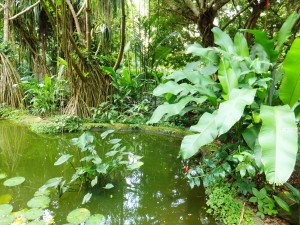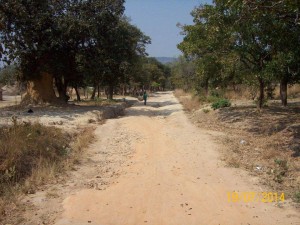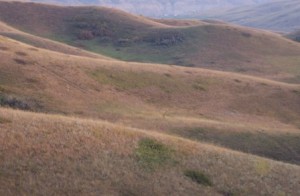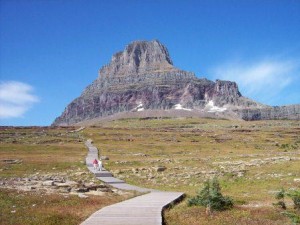Biomes (Chapter 20)
Worth reflecting on …
Eugene Peterson, pastor, professor, and author of The Message Bible translation, writes:
“Paul designates Jesus Christ as ‘the firstborn of all creation’ (Col. 1:15) and before he finishes his sentence twice makes him the subject of the verb create. Christ and creation are inseparable, indivisible. Creation is as much a part of the evangelical Gospel as Christ is. So why is it so common among us to separate Christ from creation, creation from Christ? There are plenty of exceptions, of course, but the creation people aren’t conspicuous for showing up in church with the followers of Christ as they learn the scriptures and nurture their souls. And the Christ people are far outnumbered by the creation people who are out hiking mountain trails and taking in the exuberance of birds in flight.
“I was fortunate enough to grow up in a part of Christ’s creation that had everything, or so it seemed to me: mountains, rivers, glaciers, forests, grizzlies and moose, warblers and hawks. I revelled in all of it. I was also fortunate to be raised in the company of followers of Jesus who knew how to sing and pray, make the scriptures alive and compelling, and live in bold witness in the world. And I loved it. But I also ended up with two sets of friends, the creation people and the Christ people. I could never quite figure out why there was so little crossover among them.
“I am (now) delighted to find people who are as committed to creation as to Christ, as committed to Christ as creation. I find myself completely at among in an evangelical company of people who are as at home in the creation of Christ as they are with the Christ who creates. It is a wonderful thing to join hearts and minds and muscles with companions in faith who refuse to ‘put asunder’ the Christ and creation that God has joined together.”
Peterson, Eugene, 2003. Christ and Creation. A Rocha Canada Newsletter 16:1.
Here is a brief video introduction to this week (my apologies, I have not yet done a full video lecture for this chapter): http://youtu.be/c3hLizYixIA
I. Biomes
Biogeography studies the spatial distribution of plant an animal life. It considers the distribution of ecosystems in different locations.
Biographers identify several largescale biogeographic realms or ecozones – regions with similar plant and animal characteristics. These are generally bounded by climatic and topographic barriers like deserts, mountain ranges, and oceans. These generally are associated with the major continental land masses. There are eight of these typically recognized globally.
- See Figure 20.1, “Biogeographic realms,” 4CE, p. 642 (3CE p. 624).
A biome is defined as a large, stable terrestrial or aquatic ecosystem characterized by specific plant and animal communities. Biomes are classified according to their predominant vegetation type and the organisms present. This a more commonly used classification than biogeographical realms as it is more finely tuned and recognizes that some regions are similar on different continents (e.g. western North America and western Europe). There are 12 commonly recognized biomes (two are subdivided further, for a total of 14).
- See Figure 20.7, “Major terrestrial biomes,” 4CE, p. 648-9 (20.5; 3CE pp. 628-629). This map shows the standard terrestrial — land-based (not oceanic) – biomes that biogeographers and ecologists recognize today. This figure maps the general ecosystems, taking into account both distinctive plant and animal communities.
- See Table 20.1,”Terrestrial Biomes and Their Characteristics” (4CE p. 650). This table gives more detail on each of the 12 major biomes (you do NOT need to remember all the technical details)
Note that there is a high degree of correlation between biomes (Figure 20.7), and climate (Compare Figure 10.2 (3CE Figure 10.6), “World climates according to the Köppen-Geiger classification system,” 4CE. pp.280-281 (3CE pp.272-273)). This should not be too surprising. Climate (insolation, temperature, precipitation) has profound effects upon ecosystems (vegetation, animal life). Thus we would expect that the ecosystem in a specific region would reflect, to some extent, the climate of that region.
Bi0mes are not discreet units. One doesn’t simply end and another begin. There is a transition zone where characteristics of both regions are present. Ecotones are boundary zones between ecosystems, that have share characteristics of different communities.
Biomes are classified by the species that are native to an area. Today, few regions of the world display only native species. Human activity has altered the species present intentionally or unintentionally introducing invasive (or alien, or exotic) species (through agriculture, forestry, urbanization, introduction of species from other regions, and other activities). Please read the section on “Invasive Species” (4CE pp. 644-647). You do not need to know specific examples, but please be familiar with the concept.
II. Global Biomes
This biome coincides with Af/Am climate regions (warm, wet all year). There is always a soil moisture surplus (runoff).
The climatic conditions allow for vast amounts of vegetation to flourish (remember, these biomes have the highest net primary productivity of any terrestrial biome). Vegetation often develops in distinct levels:
– High level canopy or overstory – tall trees that form a discontinuous “roof” over the forest.
– Middle level canopy – medium level trees that form a dense blanket
– Lower level canopy or understory – that receives little light and has little vegetation.
See Page 652, “Vertical Structure of a Rain Forest” (4CE, 20.1a-c), (“The three levels of a rain forest canopy” Figure 20.6 (3CE p. 631), and “The rain forest,” Figure 20.7 (3CE, p. 631)).
Because of the heavy rainfalls in this area, soils are heavily leached and oxidized. Most of the nutrients plants receive come from rotting organic mater. So … when the forest is cleared and the rotting matter burned, the soils themselves are very infertile, and can grow little vegetation. Rain forests are very slow to regenerate after being removed.
2. Tropical Seasonal Forest and Scrub
In a transitional zone between the lush vegetation of the equatorial regions and the grasslands and deserts of the subtropical high pressure belt is a biome with a mixture of forest and grassland, scrub trees and thorn bushes.
This is in warm regions with strong monsoon (Am) climates or seasonal wet and dry climates. At times during the year, there is a soil moisture deficit – at other times a soil moisture surplus.
3. Tropical Savanna
In even more arid regions, close to the subtropical high pressure belts, trees cannot survive, and natural grasslands, or savanna, result. These regions are always warm, but also are almost always quite dry, with just enough moisture to allow grass to grow, but few trees or shrubs. A soil moisture deficit, all year round, is common. In a particularly dry year (drought), these regions – including both their plant and animal life – can be devastated.
These usually coincide with Aw (tropical savanna) climates.
During extended dry periods, dissolved salts may drawn to the surface, crating infertile salt deposits.
4. Midlatitude Broadleaf and Mixed Forest
On the other side of the sub tropical high pressure belts, in temperate, continental climates, deciduous (broadleaf) and mixed (deciduous and evergreen) forests develop. These cover the St. Lawrence Valley and southern Ontario, the Maritimes, much of the eastern United States, western Europe, and China.
These regions have warm summers but cool winters. They are usually C (mesothermal) climates with cool winters and reasonable amounts of precipitation. There may be seasonal soil moisture deficits, but also soil moisture surpluses, so forests have plenty of moisture to grow.
Soils tend to be relatively well-balanced in terms of pH, with deciduous cover. In areas with much rainfall, soils may be heavily leached. In Canada these are typically luvisols.
5. Needleleaf Forest and Montane Forest
North of the deciduous/broadleaf forest is a region of evergreen or needleleaf forest, sometimes called the boreal forest or taiga. This covers most of Canada (including Alberta, from about Calgary north) and eastern Europe/Russia.
Evergreen trees tolerate cold weather better than deciduous trees, so these forests exist in regions with cooler summers and very cold winters.
Because of adiabatic cooling, similar forests exist at high elevations further south, too – montane forests are evergreen forest found at high, cold elevation – for instance in the Rocky Mountains south into the southern United States, in mountainous regions of Ethiopia (east Africa), in the foothills of the Himalayas, and in upland regions in south-east Asia.
These coincide with D (microthermal) climates – cool. Montane forests in southern latitudes coincide with H (highland) climates.
Because of the cold temperatures, acidic nature of evergreen vegetation, and reasonable amounts of moisture, soils tend to develop slowly, are quite acidic, and may be heavily leached. In Canada these are often luvisols and brunisols.
6. Temperate Rain Forests
On the west coasts of mid latitude continents, moderating, moist ocean effects create relatively warm, damp climates. These allow for the development of rain forests, like the western Canadian fir/cedar forests along the west coast, and the Redwood forests of California.
These coincide with C (mesothermal; marine west coast) climate, with mild temperatures and high precipitation.
Soils in these reigns tend to be very acidic (evergreen trees), and heavily leached (lots of rainfall). In Canada these are typically podzols.
7. Mediterranean Shrubland
In midlatitude regions with hot, dry summers and cool winters (like the Mediterranean region – France, Italy, Spain, Greece, Turkey – coastal Australia, and central California), shrubs tend to predominate. This region is also called chaparral in California.
These coincide with C (mesothermal) climate, with very little precipitation and very hot summers.
Soils are often in a constant soil moisture deficit.
8. Midlatitude Grasslands
In the interior of contents, with drier climate, grasslands predominate. The southern Canadian prairies (from about Calgary south), mid-western United States, and the Ukraine are natural midlatitude grasslands.
These coincide with C (mesothermal) climate regions, with limited precipitation.
Soils are less acidic, and often very fertile – typically chernozems in Canada. Irrigation may be necessary, however, in order to provide enough moisture for crops to grow.
9. Deserts
Deserts exist in warm, dry climates — the subtropical high pressure belts, like north Africa (the Sahara), the Middle East, the Australian Outback, and south-western United States.
Deserts also exist in cooler, dry areas – eastern Oregon and Washington, central Asia, southern Argentina. In Canada, portions of the interior of B.C. (around Kamloops and the southern Okanagon), southeastern Alberta and southwestern Saskatchewan, border on being cold deserts.
Deserts basically coincide with B (dry arid and semi-arid) climate regions.
10. Arctic and Alpine Tundra
In very cold, dry environments, permafrost (ground permanently below 0°C) is the dominant condition. In these conditions, soil is essentially nonexistent. Trees do not grow. Mosses, lichens and short grasses may grow.
In Canada, the northern territories (north of the tree line) and Arctic Islands fall into this category. The west and north coasts of Alaska, coastal Greenland, Iceland, portions of Scandinavia, and northernmost Siberia also are Arctic tundra.
At extremely high elevations further south, like the Himalayas and Andes Mountains, similar ecosystems exist. In these circumstances, high elevations and adiabatic cooling creates climatic conditions similar to those in the high Arctic. The alpine tundra biomes in these areas are almost identical to the arctic tundra near the poles.
See: Montane grasslands and shrublands
These biomes coincide with ET (arctic tundra) and H (highland) climate regions.
Worth reflecting on …
Reflecting on human interactions with the environment, Calvin De Witt, former professor at Calvin College and the University of Michigan, Director of Au Sable Institute of Environmental Studies, also discusses Three Biblical Principles For Environmental Stewardship:
- Earthkeeping Principle:
AS THE LORD KEEPS AND SUSTAINS US, SO MUST WE KEEP AND SUSTAIN OUR LORD’S CREATION
Genesis 2:15 expects Adam and Adam’s descendants to serve and keep the garden. The Hebrew word upon which the translation of keep is based is the word “shamar” and “shamar” means a loving, caring, sustaining keeping. This word also is used in the Aaronic blessing, from Numbers 6:24, “The Lord bless you and keep you.” When we invoke God’s blessing to keep us, it is not merely that God would keep us in a kind of preserved, inactive, uninteresting state. Instead, it is that God would keep us in all of our vitality, with all our energy and beauty. The keeping we expect of God when we invoke the Aaronic blessing is one that nurtures all of our life-staining and life-fulfilling relationships– with our family, spouse, and children, with our neighbors and our friends, with the land and creatures that sustain us, with the air and water, and with our God.
And so too with our keeping of the Garden– in our keeping of God’s Creation. When Adam, Eve, and we, keep the Creation, we make sure that the creatures under our care and keeping are maintained with all their proper connections– connections with members of the same species, with the many other species with which they interact, with the soil, air and water upon which they depend. The rich and full keeping that we invoke with the Aaronic blessing is the kind of rich and full keeping that we should bring to the garden of God– to God’s creatures and to all of Creation. As God keeps believing people, so should God’s people keep Creation.
- Sabbath Principle:
WE MUST PROVIDE FOR CREATION’S SABBATH RESTS
Exodus 20 and Deuteronomy 5 require that one day in seven be set aside as a day of rest for people and for animals. As human beings and animals are to be given their times of sabbath rest, so also is the land. Exodus 23 commands, “For six years you shall sow your land and gather in its yield; but the seventh year you shall let it rest and lie fallow, that the poor of your people may eat; and what they leave the wild beasts may eat.” “You may ask, ‘What will we eat in the seventh year if we do not plant or harvest our crops?'” God’s answer in Leviticus 25 and 26 is: “I will send you such a blessing in the sixth year that the land will yield enough for three years,” so do not worry, but practice this law so that your land will be fruitful. “If you follow my decrees and are careful to obey my commands, I will send you rain in its season, and the ground will yield its crops and the trees of the field their fruit”
Christ in the New Testament clearly teaches that the Sabbath is made for the ones served by it– not the other way around. Thus, the sabbath year is given to protect the land from relentless exploitation, to help the land rejuvenate, to help it get things together again; it is a time of rest and restoration. This sabbath is not merely a legalistic requirement; rather, it is a profound principle. Thus in some Christian farming communities, the sabbath principle is practiced by letting the land rest every second year, “because that is what the land needs.” And of course, it is not therefore restricted to agriculture but applies to all Creation. The Bible warns in Leviticus 26, “…if you will not listen to me and carry out all these commands, and if you reject my decrees and abhor my laws and fail to carry out all my commands and so violate my covenant, …Your land will be laid waste, and your cities will lie in ruins… Then the land will enjoy its sabbath years all the time it lies desolate… then the land will rest and enjoy its sabbaths. All the time that it lies desolate, the land will have the rest it did not have during the sabbaths you lived in it.”
- Fruitfulness Principle:
WE SHOULD ENJOY, BUT MUST NOT DESTROY, CREATION’S FRUITFULNESS
The fish of the sea and the birds of the air, as well as people, are given God’s blessing of fruitfulness. In Genesis 1:20 and 22 God declares, “Let the water teem with living creatures, and let birds fly above the earth across the expanse of the sky.” And then God blesses these creatures with fruitfulness: “Be fruitful and increase in number and fill the water in the seas, and let the birds increase on the earth.” God’s Creation reflects God’s fruitful work– God’s fruitful work of giving to land and life what satisfies. As it is written in Psalm 104, “He makes springs pour water into the ravines; it flows between the mountains. They give water to all the beasts of the field; the wild donkeys quench their thirst. The birds of the air nest by the waters; they sing among its branches. He waters the mountains from his upper chambers; the earth is satisfied by the fruit of his work.” And Psalm 23 describes how our providing God “… makes me lie down in green pastures, … leads me beside quiet waters, … restores my soul.”
As God’s fruitful work brings fruit to Creation, so too should ours. As God provides for the creatures, so should we people who were created to reflect God whose image we bear. Imaging God, we too should provide for the creatures. And, as Noah spared no time, expense, or reputation when God’s creatures were threatened with extinction, neither should we. Deluges– in Noah’s time of water, and in our time of floods of people– sprawl over the land, displacing God’s creatures, limiting their potential to obey God’s command, “be fruitful and increase in number.” To those who would allow a human flood across the land at the expense of all other creatures, the prophet Isaiah warns: “Woe to you who add house to house and join field to field till no space is left and you live alone in the land” (Isa. 5:8).
Thus, while expected to enjoy Creation, while expected to partake of Creation’s fruit, we may not destroy the fruitfulness upon which Creation’s fullness depends. We must, with Noah, save the species whose interactions with each other, and with land and water, form the fabric of the biosphere. We should let the profound admonition of Ezekiel 34:18 reverberate and echo in our minds:
“Is it not enough for you to feed on the green pastures?
Must you also trample them with your feet?
“Is it not enough for you to drink the pure water?
Must you also muddy it with your feet?”
Feel free to discuss this quote on the course discussion site …
To review …
Check out the resources at Welcome to mygeoscience place.
This page is the intellectual property of the author, Bruce Martin, and is copyrighted © by Bruce Martin. This page may be copied or printed only for educational purposes by students registered in courses taught by Dr. Bruce Martin. Any other use constitutes a criminal offence.
Scripture quotations marked (NLT) are taken from the Holy Bible, New Living Translation, copyright © 1996. Used by permission of Tyndale House Publishers, Inc., Wheaton, Illinois 60189. All rights reserved









